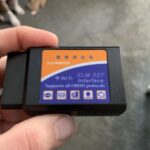Experiencing trouble connecting your BAFX OBD2 reader to your 1999 Miata? It’s a common frustration for car enthusiasts diving into DIY diagnostics. You’re not alone if you’re facing the dreaded “No response from vehicle ECU” message on apps like Torque or Car Gauge Lite. Let’s troubleshoot why your BAFX OBD2 adapter might not be communicating with your NB Miata, even though it works perfectly on your ’98 Civic.
It’s understandable to question if you’re missing a step or using the wrong port. Many Miata owners, especially those new to OBD2 diagnostics, encounter similar hurdles. Let’s break down the common questions and get your BAFX OBD2 reader working with your Miata.
Is a Special Protocol Needed for a ’99 Miata OBD2 Connection?
Generally, you shouldn’t need to manually specify a protocol when using a standard OBD2 reader on a ’99 Miata. OBD2 is designed to be plug-and-play, automatically detecting the vehicle’s communication protocol. Apps like Torque usually have an “Auto” protocol setting for this reason.
However, sometimes automatic detection can fail. While less common, it’s worth checking if your app allows you to manually select a protocol. The 1999 Miata (NB generation) uses standard OBD2 protocols, likely ISO 9141-2 or similar. Refer to your app’s settings to see if manual protocol selection is an option and experiment if auto-detect continues to fail. But before diving into protocol specifics, let’s address the more fundamental aspects of connection.
Are You Using the Correct OBD2 Port Location on Your Miata NB?
This is a crucial point. While you found a port under the fuse box cover to the left of the driver’s knee, this might not be the primary OBD2 port location intended for diagnostic tools. Mechanics often access a more easily reachable port.
For the 1999 Mazda Miata (NB), the OBD2 port is typically located in the driver’s side footwell, lower than the fuse box area. You’ll usually find it near the center console or slightly towards the driver’s seat, often tucked up under the dash. It’s worth getting down and looking carefully with a flashlight. This location is designed for easier access and less obstruction than the one you initially found.
Alt text: Locating the OBD2 port in a 1999 Mazda Miata NB footwell area beneath the dashboard.
Using the port under the fuse box might be causing your connection issues, or it could be for a different purpose altogether. Double-check the footwell area for the standard OBD2 port – it’s usually a black, 16-pin trapezoidal connector.
BAFX OBD2 Reader Compatibility with Miata NB: Is it Picky?
While the BAFX OBD2 reader is generally well-regarded and compatible with many vehicles, it’s true that some cars can be “pickier” with aftermarket OBD2 devices. However, the 1999 Miata NB isn’t known to be exceptionally problematic with standard OBD2 readers.
Before considering compatibility as the primary issue, ensure you’re:
- Using the correct OBD2 port (the lower one in the footwell).
- The BAFX adapter is powered on. You mentioned a red light, which is a good sign, indicating it’s receiving power from the OBD2 port. If the Bafx Obd2 Lights are not illuminating, there might be a power issue with the adapter or the port itself.
- Bluetooth pairing is successful. Double-check that your Android device is properly paired with the BAFX adapter via Bluetooth settings, using the correct code (1234).
- The app is correctly configured. Ensure the Torque or Car Gauge Lite app is set up to connect via Bluetooth and is searching for OBD2 adapters. Restart the app and your phone to rule out software glitches.
- Try with the engine running and ignition on. While some basic OBD2 functions might work with just the ignition on, a full ECU connection for diagnostics often requires the engine to be running. Test connection attempts in both states.
If you’ve confirmed all of these points and still face “No response from vehicle ECU,” then it might be worth considering the BAFX reader’s compatibility, although it’s less likely the root cause if it works on your Civic.
Alt text: BAFX OBD2 Bluetooth adapter, a popular tool for car diagnostics and monitoring.
Next Steps for Troubleshooting Your BAFX OBD2 and Miata Connection
If you’ve tried these steps and still can’t connect, consider these further actions:
- Try a different OBD2 app: While Torque and Car Gauge Lite are popular, try other OBD2 apps from the Google Play Store to see if a different app establishes a connection. Some apps might have slightly different communication protocols or handling.
- Test the BAFX reader on another OBD2 compliant vehicle (if possible): You mentioned it works on your Civic, which is a good baseline. If you have access to another OBD2 compliant car, try the BAFX reader there to further confirm it’s functioning correctly.
- Inspect the Miata OBD2 port: Check the pins in the Miata’s OBD2 port for any damage or corrosion. A damaged port can prevent proper communication.
- Consider a different OBD2 reader (as a last resort): If all else fails, and you suspect compatibility, you could explore other OBD2 reader brands or models. However, given the BAFX reader’s general reputation, this should be considered after exhausting other troubleshooting steps.
Connecting your OBD2 reader to your Miata should be straightforward. By systematically checking these points, you’ll likely pinpoint the reason for the connection issue and get your BAFX OBD2 adapter working to its full potential. Happy diagnosing!

